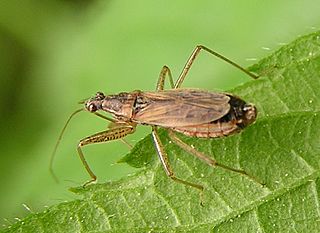
The insect family Nabidae contains the damsel bugs. There are over 500 species in 20 genera. They are soft-bodied, elongate, winged terrestrial predators. Many damsel bugs catch and hold prey with their forelegs, similar to mantids. They are considered helpful species in agriculture because of their predation on many types of crop pests.
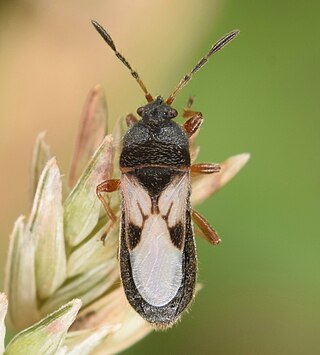
Blissus leucopterus, also known as the true chinch bug, is a small North American insect in the order Hemiptera and family Blissidae. It is the most commonly encountered species of the genus Blissus, which are all known as chinch bugs. A closely related species is B. insularis, the southern chinch bug.
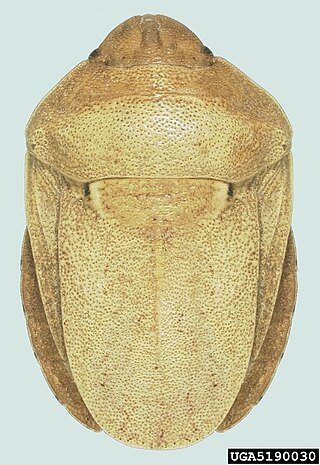
Sunn pests are grain insect pests belonging to several genera of the 'shield bug' family Scutelleridae, with the species Eurygaster integriceps being the most economically important. Sunn pests are found in parts of North Africa, throughout West Asia and many of the new independent states of Central Asia.

Berytidae is a family of the order Hemiptera, commonly called stilt bugs or thread bugs. Most berytids are brown to yellow, with species that are plant sap feeders, a few being predaceous. About 200 species are known from all around the world and they are classified into three subfamilies.

Dolycoris baccarum, the sloe bug or hairy shieldbug, is a species of shield bug in the family Pentatomidae.
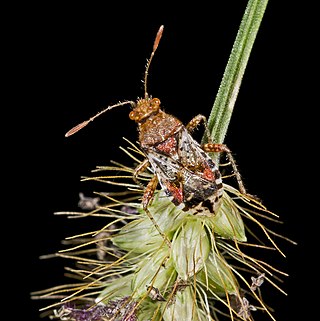
Rhopalidae, or scentless plant bugs, are a family of true bugs. In older literature, the family is sometimes called "Corizidae". They differ from the related coreids in lacking well-developed scent glands. They are usually light-colored and smaller than the coreids. Some are very similar to the orsilline lygaeids, but can be distinguished by the numerous veins in the membrane of the hemelytra. They live principally on weeds, but a few are arboreal. All are plant feeders. The type genus for the family is: Rhopalus. Currently 30 genera and over 240 species of rhopalids are known. The oldest fossil rhopalids described are from the Middle Jurassic of Inner Mongolia, discovered from the Haifanggou Formation. They are not considered economically important with a few species being pests of ornamental trees.

Leptoglossus zonatus is a species of leaf-footed bug, a type of true bugs. It is found throughout much of South America, Central America, Mexico, and the southwestern United States. The bug is two centimeters in length, gray in color, with a zigzagging whitish band across its back and two distinctive yellowish spots on its anterior pronotum, the identifying characteristic for the species.

Leptoglossus is a genus of true bugs in the leaf-footed bug family and the tribe Anisoscelini. Species are distributed throughout the Americas, with some records in eastern & southern Asia and Europe. Several species are economic pests of agricultural crops. Like members of some other genera in the family, these bugs have leaflike dilations of the hind tibia. Several species are of economic importance, and one species, L. chilensis, has been reported to bite humans.

Gargaphia solani is a subsocial species of lace bug commonly known as the eggplant lace bug. The species was described by Heidemann in 1914 after it aroused attention a year earlier in the United States as an eggplant pest around Norfolk, Virginia. Fink found that the species became an agricultural pest when eggplant is planted on a large scale.

Spilostethus pandurus is a species of "seed bugs" belonging to the family Lygaeidae, subfamily Lygaeinae.

Lygocoris rugicollis is a widespread, common species of bug in the Miridae family. It feeds on a large variety of bushes and small trees, but especially willows and slightly less often alders. It can be found throughout Europe, including the UK, and Spain, in North Africa, as far east as Central Asia, in Alaska and Canada, including the Maritimes.

Oxycarenus is a genus of ground bugs belonging to the family Lygaeidae, subfamily Oxycareninae. There are approximately fifty-five described species of Oxycarenus, and a number are documented as important crop pests.

The Blissidae are a family in the Hemiptera, comprising nearly 50 genera and 400 species. The group has often been treated as a subfamily of the Lygaeidae but was resurrected as a full family by Thomas Henry (1997).

Acompocoris alpinus is a true bug in the family Anthocoridae. The species is found in Europe. It occurs on conifers, where it is a predator of aphids. In France at an altitude of 1,200 – 2,000 m. A. alpinus Reuter, is found on Abies and Picea

Dysdercus cingulatus is a species of true bug in the family Pyrrhocoridae, commonly known as the red cotton stainer. It is a serious pest of cotton crops, the adults and older nymphs feeding on the emerging bolls and the cotton seeds as they mature, transmitting cotton-staining fungi as they do so.

Euthyrhynchus floridanus, the Florida predatory stink bug, is a species of carnivorous shield bug in the family Pentatomidae, the only species in the genus Euthyrhynchus. It is native to the hottest parts of the southeastern United States and is considered beneficial because its diet includes many species of pest insects.
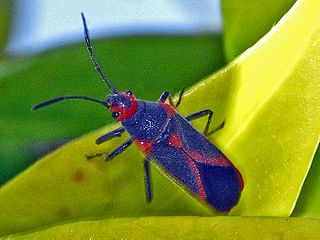
Caenocoris nerii, common name oleander seedbug, is a species of ground bugs in the insect family Lygaeidae.
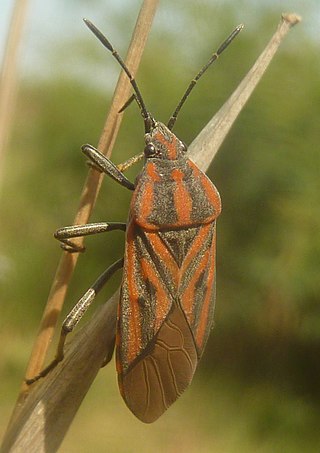
Spilostethus rivularis, the rivulet milkweed bug, is a species of bug belonging to the family Lygaeidae sensu stricto, and subfamily Lygaeinae. It is widely distributed in Africa, where it is found commonly in grassland, savannah grassland or croplands.
Oxycarenus laetus, commonly known as the dusky cotton bug, is a species of plant bug belonging to the family Lygaeidae. It is sometimes known as the Egyptian cotton stainer, and is found in southern Asia where it is a pest of cotton, okra and other crops.
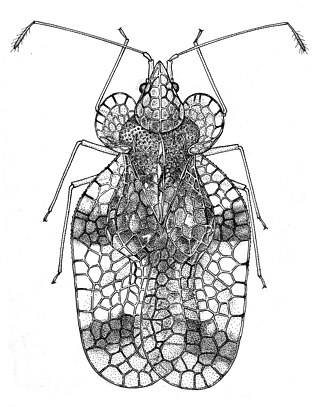
Stephanitis pyri, the pear lace bug, is a species of lace bug in the family Tingidae. It is found in Northern Africa, Southern and Central Europe, and Asia. The species is considered a pest for apple and pear trees, and is said to be polyphagous. S.pyri was first described by Johan Christian Fabricius in 1775.


















